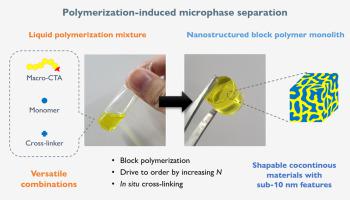Progress in Polymer Science ( IF 27.1 ) Pub Date : 2023-08-16 , DOI: 10.1016/j.progpolymsci.2023.101738 Taeseok Oh , Suchan Cho , Changsu Yoo , Wonjune Yeo , Jinyeong Oh , Myungeun Seo

|
Block polymers comprising covalently joined polymeric segments represent a class of nanostructured, multicomponent polymeric materials. Polymerization-induced microphase separation (PIMS) is an intriguing subset that allows for simultaneous nanostructuring during block polymer synthesis. In contrast to polymerization-induced self-assembly (PISA), useful for the spontaneous formation of block polymer micelles, PIMS is well suited to fabricating monolithic block polymer materials by turning a whole polymerization mixture into a nanostructured solid. With the in situ cross-linking feature, PIMS offers a facile route to nanostructured block polymer thermosets in combination with various polymerization techniques, from emulsion polymerization to 3D printing. This review aims to provide a comprehensive overview and practical guide on PIMS by covering its historical background and mechanistic aspects and also highlighting representative material classes and applicable polymerization techniques.
中文翻译:

聚合诱导的聚合混合物微相分离成纳米结构嵌段聚合物材料
包含共价连接的聚合物链段的嵌段聚合物代表一类纳米结构的多组分聚合物材料。聚合诱导微相分离(PIMS)是一个有趣的子集,它允许在嵌段聚合物合成过程中同时进行纳米结构。与可用于自发形成嵌段聚合物胶束的聚合诱导自组装 (PISA) 相比,PIMS 非常适合通过将整个聚合混合物转变为纳米结构固体来制造整体嵌段聚合物材料。随着原地凭借交联功能,PIMS 与从乳液聚合到 3D 打印等各种聚合技术相结合,为纳米结构嵌段聚合物热固性材料提供了一种简便的途径。本综述旨在通过涵盖其历史背景和机理方面,并重点介绍代表性材料类别和适用的聚合技术,为 PIMS 提供全面的概述和实用指南。



























 京公网安备 11010802027423号
京公网安备 11010802027423号